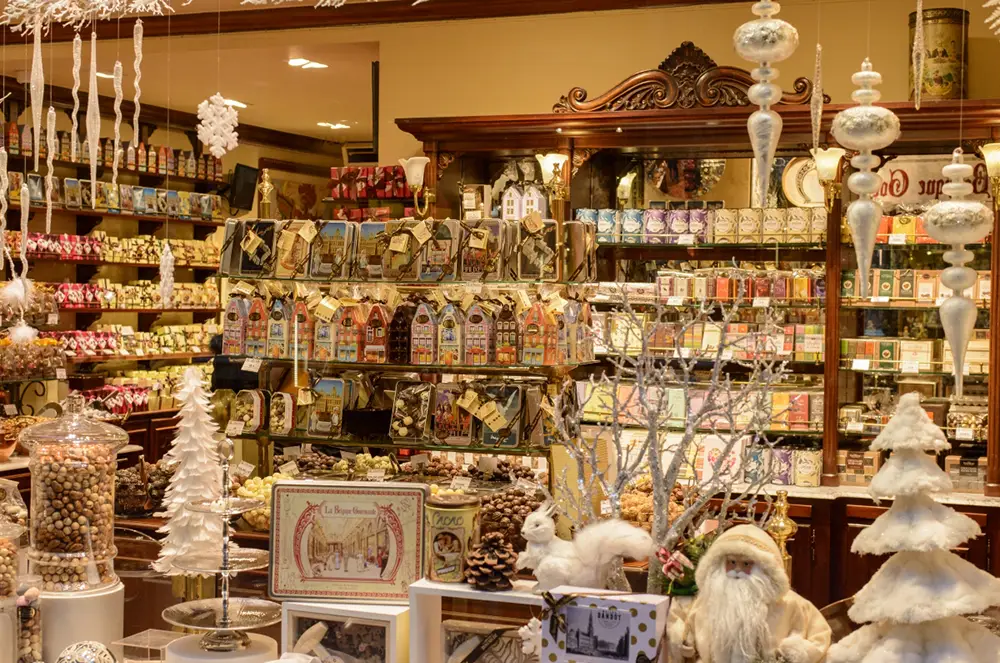Chocolate Confectionery: Permission to Launch
October 2, 2017
More than other similar indulgences, consumers give themselves permission to enjoy chocolate. Despite widespread health and wellness lifestyles, and a clear consumer focus on reducing sugar intake, the chocolate category enjoys a solid popularity. About 85% of U.S. consumers report buying chocolate and 93% eat it. This loyalty to the category is evident in expectations that the U.S. chocolate market will see 19% sales growth through 2020.
Contributing to this expected growth: premiumization, increased availability and higher quality offerings. Let’s take a look at the world of chocolate, a regular indulgence for nearly all American consumers.

Flavors
Chocolate is always a top flavor in product development, and it’s no exception when it comes to, well, chocolates! “Plain Chocolate” as a flavor leads chocolate launches, but there are plenty of flavor pairings, as well, with Caramel and Almond being most popular. In fact, Caramel rose 63% from 2015 to 2016. Coconut is the seventh most popular flavor we see in Chocolate Confections, having risen 77% from 2013 to 2016.
Top 10 Flavors
• Plain Chocolate
• Caramel
• Almond
• Sea Salt
• Hazelnut
• Peanut Butter
• Coconut
• Peanut
• Mint
• Toffee

First-Time Flavors
Here are a few of the flavors appearing in 2017 for the first time in this time period.
• Hawaiian Black Lava Salt
• Tea
• Applewood Smoke
• Cara Cara Orange
• Cupcake
• Coconut Water
Product Launches of Note
• Guyaux French Cocoa Dusted Truffles with Fragments of Isigny Caramel are made of bits of Isigny cream, Isigny salted butter and Gurenade salted caramel. Canada September 2017
• Eating EVOLVED Dark Chocolate Classic Coconut Butter Cups feature pure coconut ground to a rich consistency, similar to nut butter. It contains 22% Fair Trade ingredients, including Fair Trade cocoa, and is free from dairy, soy and cane sugar. The product is said to be the world’s first coconut butter cup, and is suitable for paleo and vegan diets. US November 2016
• M&Ms Vanilla Cupcake Chocolate Candies launched for Easter 2017 and is made with white chocolate. US March 2017

Top Chocolate Claims
As consumers continue to focus on how the products they purchase affect other people, animals and the planet — we see a rise in Ethical claims in the Chocolate Confections category. Between 2013 and September 2017, Ethical (Human) claims rose from 90 products to 162, a growth of 80%. It is the largest increase we see over the time period and does not come as a surprise with the increased attention being paid to the well-being of cacao bean farmers around the world. Similarly, Ethical (Environmentally Friendly Product) increased 61% with continued growth expected this year.
Top 10 Claims
• Kosher
• Seasonal
• Low/No/Reduced Allergen
• Ethical Human
• Gluten-free
• Premium
• Ethical Environmentally friendly
• Social Media
• Organic
• No Additives/Preservatives
A Closer Look: Seasonal Claims
Seasonal is the second most popular claim behind Kosher, experiencing more than 20% growth from 2013 to 2016. About half of consumers purchased seasonal-themed chocolate during the holiday months of October, November and December. But the familiar gift packages have seen a decline in sales. Beth Bloom, Associate Director of Mintel Food & Drink, suggests this can be attributed to an expansion of premium chocolate offerings with packaging that makes for a nice presentation on its own. She suggests positioning assortments as shareable or sample-able, rather than to gift, could be a useful approach.
Speaking about seasonal confections as a whole, Larry Pierce, EVP, merchandising and marketing for SpartanNash grocery stores said, “There is no limit with seasonal category growth, because it allows us to continue to surprise and delight our customers and challenge our vendor partners to be creative.” He also noted customers’ increased interest in dark chocolate and premium offerings during the holidays.
• BIJA Organic Chocolate Bar with Cherry Chia Crunch is described as an organic, direct trade chocolate made with five ingredients, including 70% cocoa. This USDA Organic, bean-to-bar product is suitable for vegans, is free from soy and GMOs. The manufacturer claims to work directly with women’s cooperatives in Dominican Republic and Peru who partner with farmers who nurture and harvest their organic cacao. They also claim to pay their workers directly, thus ensuring greater economic opportunities to help their communities and families. US August 2017
• Taza Chocolate Dark Bark Sea Salt & Almond Chocolate Snacking Thins feature 80% dark chocolate, contain only 6g of sugar per serving, and have been stone ground for a bold flavor. These USDA certified organic thins are free from GMO, dairy, soy, and gluten, are suitable for vegans and contain crispy, protein-packed puffed quinoa and the roasted almonds. The ingredients are sourced via Taza Direct Trade, which means face-to-face relationships with growers who respect the environment and fair labor practices. US June 2017
• Divine Milk Chocolate Tablet with Spiced Cookies is a limited edition product containing crumbly cookie pieces wrapped in milk chocolate with a blend of spices. It is made with the finest quality Fair Trade cocoa beans from Kuapa Kokoo, a cooperative of small-holder farmers in Ghana. Canada December 2016

A Closer Look: Vegan Claims
Whether for dietary, ethical or environmental concerns, or even just an interest in new products, vegan and vegetarian dishes and products are gaining steam. From Meatless Monday to black bean burgers at Wendy’s, we see plant-based and animal-product-free options having more of a mainstream presence – and that includes in Chocolate Confections.
From 2012-2016, there were 203 chocolate confections launches carrying the Vegan claim, reflecting almost 170% growth. The majority of those products were from US, but even though Canada’s numbers are quite small, with only 4 products last year and 13 so far this year, it’s still a steep increase.
Vegan Chocolate Flavor Spotting
• Bourbon Black Tea
• Hummingbird Nectar Tea
• Salted Caramel Marshmallow
• Coffee Crunch
• Tokyo Toffee
• Smoky Corn on the Cob
• Spiked Eggnog
• Cinnamon, Cayenne & Cherries Bar
• Blackberry Sage
• Cherries, Sunflower Seeds and Sea Salt Bar

Chocolate and Health
As consumers continue to weigh health and wellness when making food and beverage choices, chocolate remains buoyed by customers who reach for chocolate as a permissible indulgence or select chocolates with healthier ingredient profiles, and those who know their favorite confections are not health food, but simply are not concerned about it.
According to Mintel, health is not a decision-making factor for 83% of chocolate-buying consumers. When asked why they don’t take health into consideration, nearly half of these consumers said it’s a splurge they allow, and 20% said they simply aren’t going to give up chocolate for health. We see this refusal to compromise chocolate for health in the meager 1% of launches carrying the Sugar Free claim, despite the intense focus on reducing sugar in American diets. People want their chocolate.
Additionally, people have a broader view of how to achieve a healthy lifestyle. 23% of consumers purchase chocolate despite it being unhealthy because they manage their health in other ways, so they aren’t concerned with effects of chocolate.
Matt Lloyd of Mars said in an interview with Confectionery News: “We continue to see health and wellness as a trend. However, what’s really important for people is they can continue to treat themselves. Not only do people want healthy products, but they definitely want treats in their diet...so we’ll continue to see growth in treating, as well as healthy snacks.”
Health-conscious consumers & functional/healthy ingredients
About 17% of consumers told Mintel that health played a role in their confections selections and some are steering clear entirely. This has encouraged chocolate manufacturers to attempt to reach these customers by adding more nutritional value to their products through the inclusion of nuts, fruits and other ingredients with positive health credentials.
K’ul brand is a perfect example with their tag line “Chocolate is not candy. Chocolate is food.” They position their chocolate as “good for you” and their website states, “Chocolate is a superfood we add ingredients to such as peanuts, pumpkin seeds, raisins, cherries, and pomegranates, which provide unique nutritional elements to forge a truly functional food.”
Quinoa
Quinoa has been a popular ingredient to up the health factor of indulgent recipes, allowing people to satisfy their sweet tooth while avoiding the sugary deep end. We’ve spotted recipes such as Chocolate Quinoa Breakfast Bowl, Fudgy Salted Quinoa Brownies, Dark Chocolate Quinoa Pudding, Sea Salt and Dark Chocolate Quinoa Energy Balls, and a plethora of chocolate quinoa cookies, cakes and muffins.
This has now transferred from the kitchen into confections with quinoa appearing in a variety of launches, bringing crunchy texture and a boost of protein to the category. And protein, as we’ve seen, is appealing to a range of consumers from parents and office workers needing an afternoon energy boost to athletes and dieters. (Chia is another ingredient providing both crunch and protein to chocolate confections.)
• 7th Street Confections Raspberry & Quinoa Dark Chocolate Thins are made with real fruit. The GMO-free product is described as tart-sweet raspberries, nutrient-packed quinoa, and rich dark chocolate. US August 2017
• Unreal Dark Chocolate Crispy Quinoa Gems are made with crispy quinoa covered in smooth dark chocolate. The candies are made with Fair Trade ingredients, are colored by veggies, and contain nothing artificial or GMOs. The kosher and vegan product contains 72% cocoa and is made with sustainable ingredients. US August 2017

Tumeric
Anyone following health and wellness enthusiasts on Instagram has certainly seen the recent increase in mentions of turmeric as colorful photos of the golden smoothies, lattes and cold pressed juices fill their feeds. Promoted as an anti-inflammatory, tumeric is often spotted paired with ginger, lemon and curry flavors. In chocolate, we see many of these same combinations, with additions of coconut and other warm spices like cardamom and nutmeg.
Here’s an area where we know there is a market (21% of consumers would drink more non-dairy milk if it contained probiotics, and 19% of US bottled water consumers’ ideal bottled water contains probiotics.), but we don’t see it reaching into the chocolate category much yet.
A recent study published in the journal Biocatalysis and Agricultural Biotechnology found that when incorporated in chocolate, good bacteria’s chances of surviving the stomach and reaching the intestines are increased. Ohso chocolate bars, which contain probiotics, promotes this newly discovered benefit of chocolate on its packaging: “Delivers live bacteria 3x more effectively than in dairy products.”

FONA CAN HELP!
Let FONA’s market insight and research experts translate these trends into product category ideas for your brand. They can help you with concept and flavor pipeline development, ideation, consumer studies and white space analysis to pinpoint opportunities in the market.
Our flavor and product development experts are also at your service to help meet the labeling and flavor profile needs for your products to capitalize on this consumer trend. We understand how to mesh the complexities of flavor with your brand development, technical requirements and regulatory needs to deliver a complete taste solution.
CONTACT OUR SALES SERVICE DEPARTMENT at 630.578.8600 to request a flavor sample or visit www.mccormickfona.com.
Mintel, Progressivegrocer.com, endorfinfoods.com, vegnews.com, confectionerynews.com, kul-chocolate.com, gooddaychocolate.com, sciencedirect.com, sciencedaily.com



